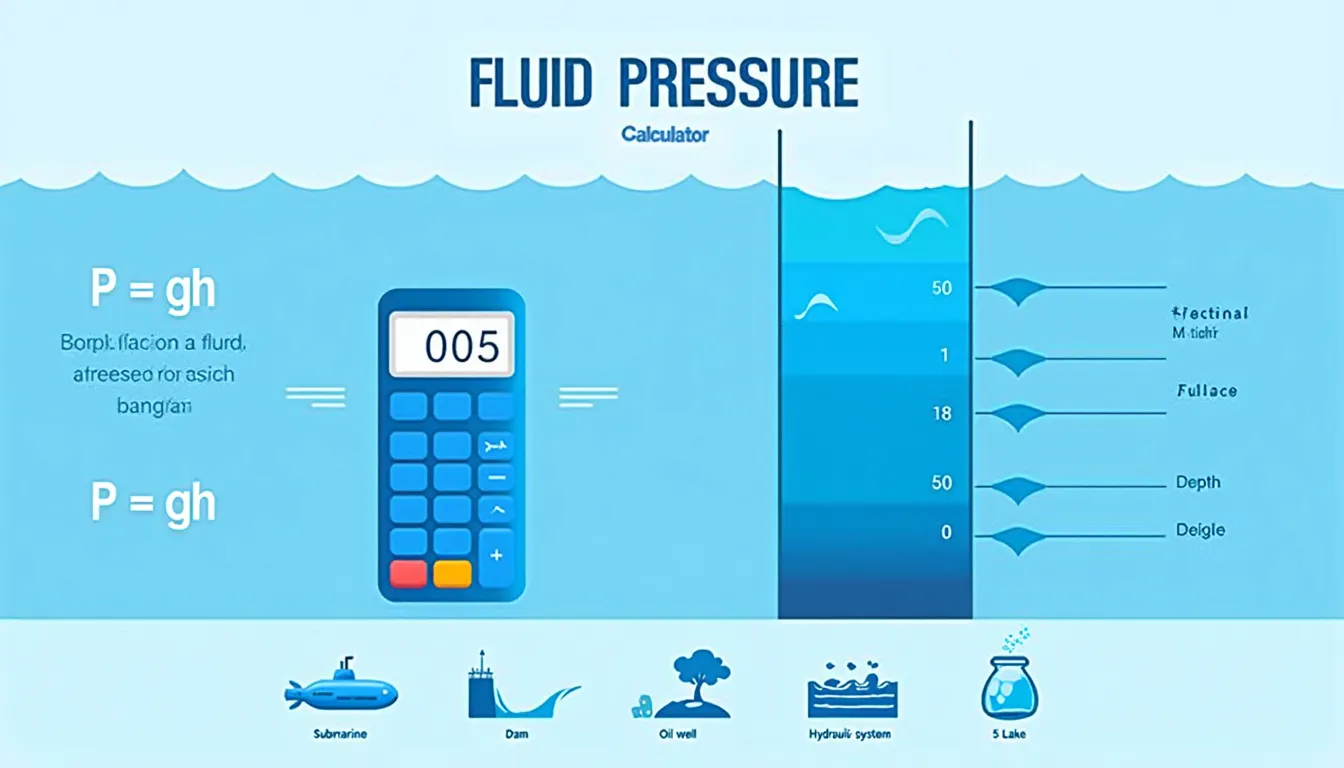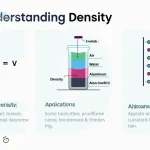Fluid Pressure Calculator
Is this tool helpful?
Welcome to our comprehensive guide on the Fluid Pressure Calculator, a powerful tool designed to help you understand and calculate hydrostatic pressure in various fluid systems. Whether you’re a student, engineer, or curious enthusiast, this calculator will provide you with accurate and quick results for your fluid pressure calculations.
How to Use the Fluid Pressure Calculator Effectively
Our user-friendly Fluid Pressure Calculator is designed to make your calculations as simple and efficient as possible. Follow these steps to get the most out of this tool:
- Enter the Fluid Density: Input the density of the fluid in kilograms per cubic meter (kg/m³).
- Specify the Depth: Enter the depth at which you want to calculate the pressure in meters (m).
- Input the Gravitational Field Strength: Provide the gravitational field strength in meters per second squared (m/s²).
- Calculate: Click the “Calculate” button to obtain your result.
- View Results: The calculated fluid pressure will be displayed in Pascals (Pa).
It’s that simple! Now let’s dive deeper into the world of fluid pressure and explore how this calculator can benefit you.
Understanding Fluid Pressure: Definition, Purpose, and Benefits
Fluid pressure, also known as hydrostatic pressure, is the force exerted by a fluid on an object immersed in it or on the walls of a container holding the fluid. This pressure is a fundamental concept in fluid mechanics and has numerous applications in various fields, including engineering, physics, and environmental sciences.
The Science Behind Fluid Pressure
Fluid pressure is governed by Pascal’s principle, which states that pressure applied to an enclosed fluid is transmitted equally in all directions. The pressure at any point in a fluid at rest depends on three key factors:
- The density of the fluid
- The depth below the fluid’s surface
- The gravitational field strength
The mathematical formula for calculating fluid pressure is:
$$P = \rho \cdot g \cdot h$$Where:
- P = Pressure (in Pascals, Pa)
- ρ (rho) = Fluid density (in kg/m³)
- g = Gravitational field strength (in m/s²)
- h = Depth below the fluid’s surface (in m)
Purpose of the Fluid Pressure Calculator
The primary purpose of our Fluid Pressure Calculator is to simplify and streamline the process of calculating hydrostatic pressure. By automating these calculations, we aim to:
- Save time and reduce the potential for human error in manual calculations
- Provide a quick and reliable tool for students, professionals, and enthusiasts
- Enhance understanding of fluid pressure concepts through practical application
- Facilitate problem-solving in various fields that deal with fluid systems
Benefits of Using the Fluid Pressure Calculator
Our Fluid Pressure Calculator offers numerous advantages to its users:
1. Accuracy and Precision
By eliminating manual calculations, our calculator ensures high accuracy in results, reducing the risk of errors that could lead to incorrect design decisions or misunderstandings of fluid systems.
2. Time-Saving
Performing fluid pressure calculations manually can be time-consuming, especially when dealing with multiple scenarios or complex systems. Our calculator provides instant results, allowing you to focus on analysis and interpretation rather than computation.
3. Versatility
The calculator can be used for a wide range of fluids and scenarios, making it a versatile tool for various applications in engineering, physics, and environmental studies.
4. Educational Value
For students and learners, the calculator serves as an excellent tool to reinforce understanding of fluid pressure concepts. It allows for quick experimentation with different variables, helping to build intuition about how changes in density, depth, or gravitational field affect pressure.
5. Professional Efficiency
Engineers and professionals working with fluid systems can use this calculator to quickly verify hand calculations or to perform rapid estimations during the design process, improving overall workflow efficiency.
Addressing User Needs: How the Fluid Pressure Calculator Solves Specific Problems
Our Fluid Pressure Calculator is designed to address several common challenges and needs faced by users working with fluid systems:
1. Quick Pressure Estimations
In many engineering and scientific applications, it’s necessary to quickly estimate fluid pressure at various depths. Our calculator allows for rapid calculations, enabling users to make informed decisions on the spot.
2. Comparative Analysis
By easily adjusting input parameters, users can compare pressure values for different fluids or depths. This feature is particularly useful when designing systems that involve multiple fluids or varying depths.
3. Safety Considerations
In industries such as deep-sea exploration or underwater construction, understanding fluid pressure is crucial for safety. Our calculator helps in assessing potential risks and designing appropriate safety measures.
4. Educational Support
Students often struggle with conceptualizing fluid pressure. This calculator provides a hands-on tool to experiment with different variables, reinforcing theoretical knowledge with practical application.
5. Design Optimization
Engineers can use the calculator to optimize designs for fluid-containing structures, ensuring they can withstand the calculated pressures at various depths.
Practical Applications: Examples and Use Cases
To illustrate the versatility and practical utility of our Fluid Pressure Calculator, let’s explore some real-world applications:
1. Marine Engineering
Consider a submarine design project. Engineers need to calculate the pressure on the hull at various depths to ensure structural integrity. Using our calculator, they can quickly determine the pressure at different depths in seawater (density ≈ 1025 kg/m³).
Example calculation:
- Depth: 1000 m
- Fluid Density (seawater): 1025 kg/m³
- Gravitational Field Strength: 9.81 m/s²
Result: The pressure at 1000 m depth would be approximately 10,055,250 Pa or about 100 atmospheres.
2. Dam Construction
In dam design, engineers must account for the pressure exerted by water at different depths. Our calculator can help determine the pressure at the base of a dam, crucial for structural calculations.
Example calculation:
- Depth: 50 m (height of the dam)
- Fluid Density (freshwater): 1000 kg/m³
- Gravitational Field Strength: 9.81 m/s²
Result: The pressure at the base of a 50 m high dam would be approximately 490,500 Pa.
3. Oil and Gas Industry
In oil well design, understanding the pressure at different depths is crucial for selecting appropriate equipment and ensuring well integrity. Our calculator can help estimate these pressures quickly.
Example calculation:
- Depth: 3000 m
- Fluid Density (crude oil): 870 kg/m³
- Gravitational Field Strength: 9.81 m/s²
Result: The pressure at 3000 m depth in a crude oil well would be approximately 25,610,100 Pa.
4. Hydraulic Systems
In designing hydraulic systems, engineers need to calculate fluid pressures to select appropriate components and ensure system efficiency. Our calculator simplifies these calculations.
Example calculation:
- Depth (height of fluid column): 2 m
- Fluid Density (hydraulic oil): 870 kg/m³
- Gravitational Field Strength: 9.81 m/s²
Result: The pressure at the base of a 2 m column of hydraulic oil would be approximately 17,074 Pa.
5. Environmental Studies
Researchers studying aquatic ecosystems often need to understand pressure variations at different depths. Our calculator can assist in these environmental assessments.
Example calculation:
- Depth: 100 m (in a deep lake)
- Fluid Density (freshwater): 1000 kg/m³
- Gravitational Field Strength: 9.81 m/s²
Result: The pressure at 100 m depth in a freshwater lake would be approximately 981,000 Pa.
Frequently Asked Questions (FAQ)
1. What units should I use for input values?
Use the following units for input values:
- Fluid Density: kilograms per cubic meter (kg/m³)
- Depth: meters (m)
- Gravitational Field Strength: meters per second squared (m/s²)
2. What is the typical value for gravitational field strength?
On Earth’s surface, the gravitational field strength is approximately 9.81 m/s². However, this can vary slightly depending on location and altitude.
3. Can this calculator be used for gases as well as liquids?
Yes, the calculator can be used for both liquids and gases. However, keep in mind that gas density can vary significantly with pressure and temperature, which may affect the accuracy of results for large depth variations.
4. How accurate are the results from this calculator?
The calculator provides results accurate to two decimal places. However, the overall accuracy depends on the precision of your input values.
5. Can I use this calculator for non-Earth environments?
Yes, you can use this calculator for other planetary environments by adjusting the gravitational field strength accordingly.
6. What is the maximum depth I can calculate?
There is no theoretical maximum depth for calculations. However, extremely large values may lead to results that exceed practical applications.
7. How does temperature affect fluid pressure calculations?
This calculator doesn’t directly account for temperature effects. In reality, temperature can affect fluid density, which in turn influences pressure. For high-precision applications, consider using temperature-adjusted density values.
8. Can this calculator be used for dynamic fluid systems?
This calculator is designed for static fluid systems. For dynamic systems with flowing fluids, additional factors need to be considered, and more complex calculations may be required.
9. Is this calculator suitable for professional engineering applications?
While this calculator can be a useful tool for quick estimations and educational purposes, professional engineering applications may require more sophisticated tools that account for additional factors and provide higher precision.
10. How often is the calculator updated?
We strive to keep our calculators up-to-date with the latest scientific understanding and user feedback. However, we can’t guarantee that the webtool or results from our webtool are always correct, complete, or reliable. Our content and tools might have mistakes, biases, or inconsistencies.
Conclusion: Harnessing the Power of Fluid Pressure Calculations
Our Fluid Pressure Calculator is a powerful tool that simplifies complex hydrostatic pressure calculations, making them accessible to students, professionals, and enthusiasts alike. By providing quick, accurate results, it enables users to:
- Save time on manual calculations
- Enhance understanding of fluid pressure concepts
- Improve decision-making in fluid system design
- Explore various scenarios quickly and efficiently
- Support learning and teaching in fluid mechanics
Whether you’re designing a submarine, planning a deep-sea expedition, or simply curious about the pressures at the bottom of your local lake, our Fluid Pressure Calculator is here to assist you. Its user-friendly interface, coupled with the underlying scientific principles, makes it an invaluable resource for anyone working with or studying fluid systems.
We encourage you to explore the capabilities of this calculator, experiment with different scenarios, and discover how it can enhance your understanding and work with fluid pressure. Remember, while this tool provides valuable insights, it’s always important to combine these calculations with professional judgment and, where necessary, more detailed analysis for critical applications.
Start using our Fluid Pressure Calculator today and unlock the power of hydrostatic pressure calculations at your fingertips!
Important Disclaimer
The calculations, results, and content provided by our tools are not guaranteed to be accurate, complete, or reliable. Users are responsible for verifying and interpreting the results. Our content and tools may contain errors, biases, or inconsistencies. We reserve the right to save inputs and outputs from our tools for the purposes of error debugging, bias identification, and performance improvement. External companies providing AI models used in our tools may also save and process data in accordance with their own policies. By using our tools, you consent to this data collection and processing. We reserve the right to limit the usage of our tools based on current usability factors. By using our tools, you acknowledge that you have read, understood, and agreed to this disclaimer. You accept the inherent risks and limitations associated with the use of our tools and services.







